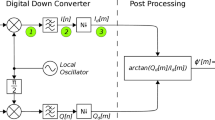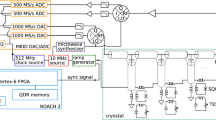Abstract
Superconducting QUantum Interference Device (SQUID) multiplexing is a common technique in the use of large arrays of Transition Edge Sensors (TES). A Time Domain Multiplexer (TDM) combines input TES signals into one output signal using several SQUIDs. Different TES, SQUID and amplifier characteristics induce unavoidable different offsets on the multiplexed signal. Additionally, given the periodicity of the SQUID characteristic, the Flux Locked Loop (FLL) operating point is only defined modulo Φ 0. This can lead to a large output offset. In multiplexed mode, the difference between offsets associated with different pixels can induce a parasitic signal which is often larger than that of the TES. These offset signals drastically constrain the readout dynamic range and thus the maximum gain allowed. They also limit the signal-to-noise ratio, the FLL stability and the multiplexing frequency.
Offsets in SQUID readout are discussed and offset compensation for TDM is presented. The dynamic calibration and compensation on a simplified 4:1 TDM are demonstrated in simulation. Dynamic offset compensation is being implemented on a cryogenic SiGe integrated circuit operated at 4 K for 128:1 TDM.





Similar content being viewed by others
References
The QUBIC Collaboration, QUBIC: The QU bolometric interferometer for cosmology. Astropart. Phys. 34 (2011)
The COrE Collaboration, COrE (Cosmic Origins Explorer) a white paper. Cosmol. Extragalact. Astrophys. (2011). arXiv:1102.2181v1
D. Prêle et al., in Cryogenic SiGe ASIC for SQUID Multiplexing, vol. 37, ed. by P. Kern (European Astronomical Society, Versoix, 2009)
F. Pajot et al., Large sub-mm and mm detector arrays for astronomy: development of NbSi superconducting bolometers. Proc. SPIE 7854 (2010)
D. Prêle et al., Standard SiGe Technologies Operating at 4 K for Front-End Readout of SQUID Arrays, ICSICT (2006)
Acknowledgements
This work is supported by CNES, CNRS, Paris Diderot and Paris-Sud universities under the BSD French R&D project (B-mode Superconducting Detectors).
Author information
Authors and Affiliations
Corresponding author
Rights and permissions
About this article
Cite this article
Prêle, D., Voisin, F., Martino, J. et al. Cryogenic Integrated Offset Compensation for Time Domain SQUID Multiplexing. J Low Temp Phys 167, 726–731 (2012). https://doi.org/10.1007/s10909-012-0606-7
Received:
Accepted:
Published:
Issue Date:
DOI: https://doi.org/10.1007/s10909-012-0606-7




